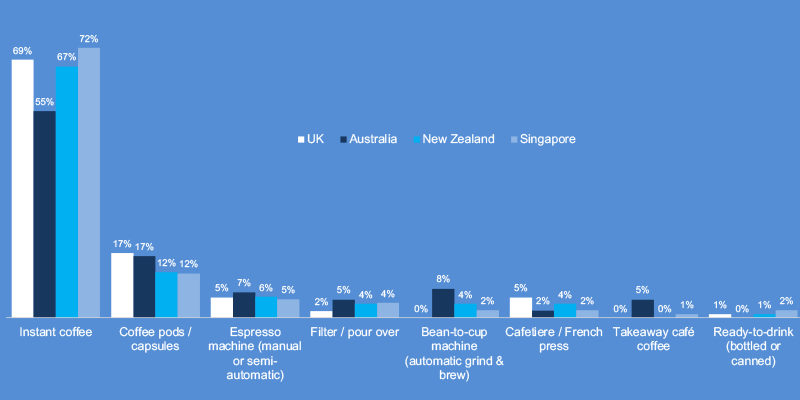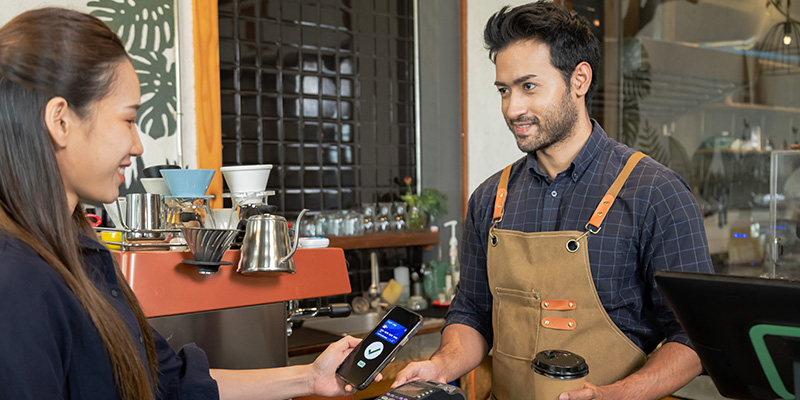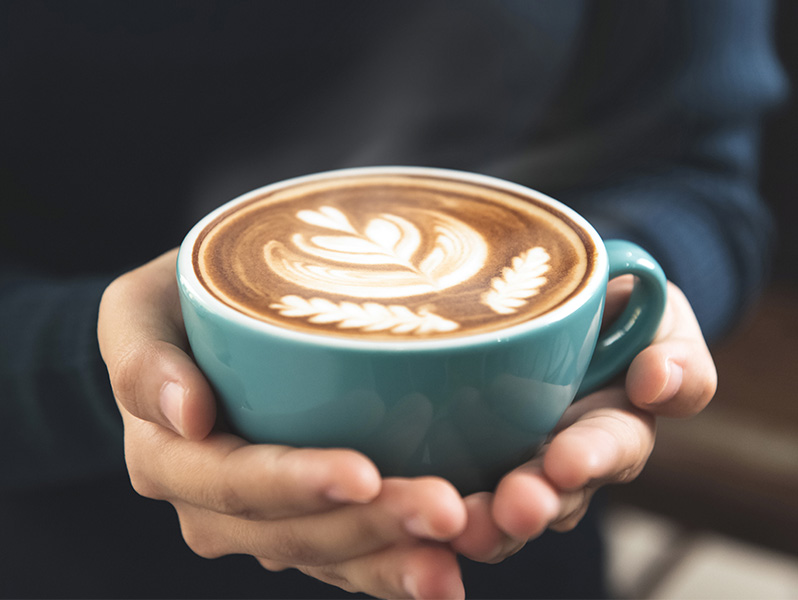
It’s International Coffee Day, 1 October and the perfect time to reflect on how deeply coffee shapes our lives. We asked shoppers in Australia, New Zealand, the UK and Singapore about their daily coffee rituals at home, in cafés and everywhere in between. What we discovered is that while coffee is universally loved, the way people purchase and enjoy it reveals some fascinating cultural quirks.
Coffee Beats Tea, Hands Down
Coffee continues to reign supreme in every market we surveyed. In Australia, the obsession is strongest, with more than eight in ten saying they regularly drink coffee. In the UK, coffee outranks tea as the daily go-to, although nearly 70% state they regularly drink tea….long may the tradition continue! While Singaporeans embrace both coffee slightly over tea, reflecting the city-state’s eclectic food and beverage culture. New Zealanders are loyal coffee drinkers but are less inclined to keep tea in the mix than in other parts of the world.
Rituals by the Cup
When it comes to daily routines, each market has its own rhythm. The British stand out as the heaviest drinkers, with over 20% consuming over four coffees per day! Australians and New Zealanders average a steady two to three cups daily, a pace that balances habit with moderation. Singaporeans, by contrast, tend to be more restrained, often limiting themselves to one cup per day.

Instant vs Pod People
Inside the home, instant coffee still holds supreme. This is especially true in Singapore, New Zealand and the UK, where over two thirds of respondents choose instant as their go to fix. Australians are less tied to the jar, with just over half preferring instant and the rest leaning into alternatives such as pods, espresso and automated machines. Coffee pod usage at home is most prevalent in the UK and Australia with 17% of consumers in both markets claiming it’s their preferred format. As for expresso machines Australia leads the trend with 15% having one at home.
Lattes, Long Blacks and Flat Whites
What people drink also depends on where they are. At home, the choices are simpler: black coffee, white coffee with milk or the occasional latte. The UK shows a clear preference for white coffee, while Singaporeans stand out for their love of both black coffee and lattes. Australians and New Zealanders are more eclectic, balancing their home habits across black and white coffees with a growing taste for café-style brews.
Step out of the house and the variety explodes. Aussies and the Brits spread their love across flat whites, lattes and cappuccinos….anyone for a twist of lemon with that?
While the Kiwis don’t mind sipping a mocha or flavoured coffee. In Singapore, no single style dominates, reflecting a market where global coffee trends meet local experimentation.
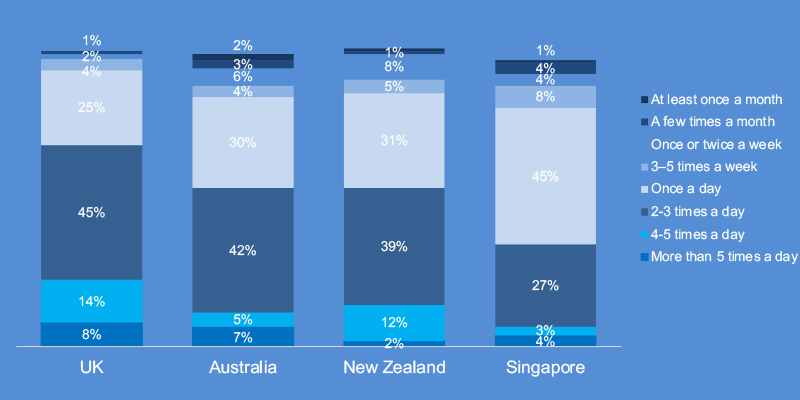 Coffee at home
Coffee at home
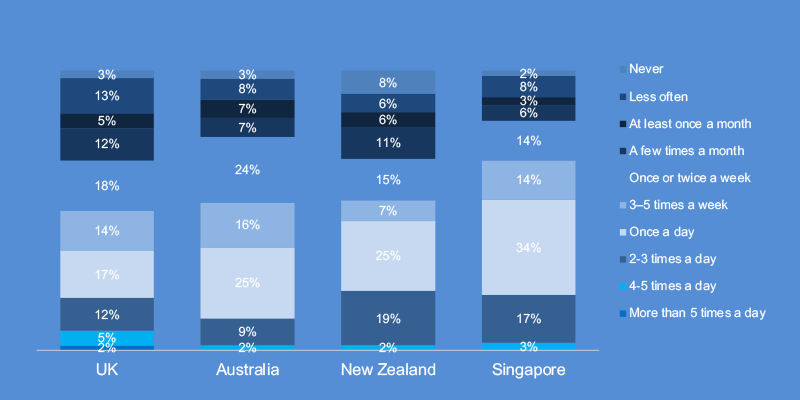 Coffee out of home
Coffee out of home
Taste Rules, But Price Talks
What shoppers look for when buying coffee to drink at home also varies. Hardly surprising, taste is the non-negotiable factor everywhere, with over 75% in all markets saying flavour is their top priority. But other values diverge: New Zealanders and Singaporeans are slightly more price-sensitive than their UK or Australian counterparts, and freshness plays a bigger role in Singapore, where more than half of shoppers actively seek recently roasted beans.
Shopping the Coffee Aisle
The path to purchase tells its own story. Supermarkets dominate across all four markets, but in Singapore the story doesn’t end there. One in three shoppers buy their coffee online, specialty shop or convenience store. That’s in stark contrast to Australia, where only one in ten rely on convenience outlets and online sales are still minimal. The UK sits between these extremes, with a quarter of consumers happily picking up coffee from a corner shop.
Can’t Live Without It
Perhaps the most revealing findings come when people describe their relationship with coffee. In Singapore, more than half say “I rely on it to get me through the day,” underlining just how central coffee is to daily life, whilst 18% are trying to cut back on consumption. New Zealanders are a little more prone to seeing it more as a social connector, with more than a quarter mainly drinking coffee when catching up with friends. Australians and Brits fall somewhere in the middle – daily home drinkers who also don’t mind a cup with friends.
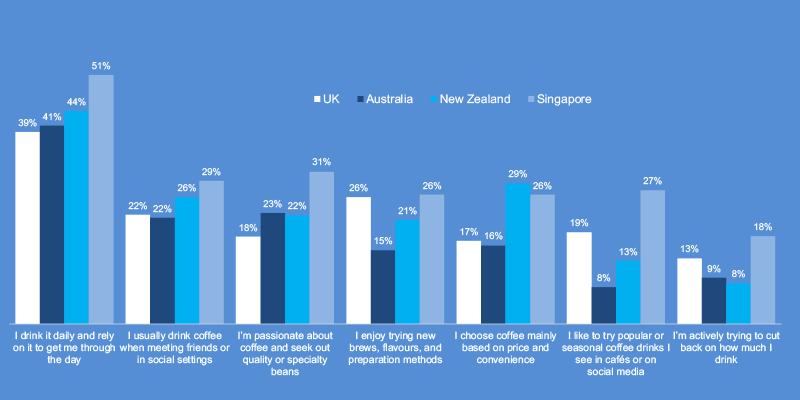
How Much for a Cuppa?
Finally, the price of a café coffee. Brits are paying the most, with an average of USD $4.80 per cup. By comparison in all other markets it’s approximately USD $3.60 for a coffee at their local café.
Universal Love with Local Rituals
Coffee is the drink that gets us moving in the morning and fuels conversations with friends, but the way we buy it, brew it and savour it reflects our culture, values and lifestyle.
For brands and retailers, the lesson is clear – success comes from recognising these local nuances and rituals while still delivering on the universal desire for taste, convenience and value.
Neil Moody, Focus Insights Regional Director ANZ, puts it simply – “Coffee is a category with both universal love and deeply local habits. These findings show that whether it’s an instant at home, a flat white at the café, or a premium pod, shoppers want taste, convenience and value delivered in their own way. Brands that get this balance right will keep winning the morning.”
If you’d like to know more about our coffee study or need shopper insights into FMCG products and categories across multiple markets we would love to hear from you. Get in touch and let’s start brewing up the insights that will fuel your next big product win!

